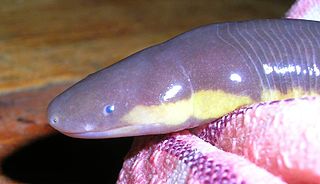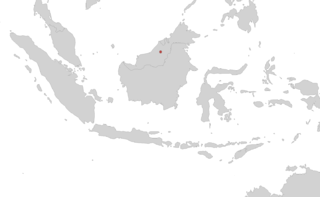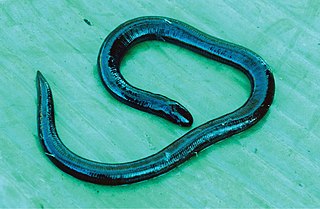
The Ichthyophiidae are the family of Asiatic tailed caecilians or fish caecilians found in South and Southeast Asia as well as southernmost China.

Ichthyophis is a genus of caecilians found in Southeast Asia, the southern Philippines, and the western Indo-Australian Archipelago.

Ichthyophis garoensis, the Garo Hills caecilian, is a species of caecilian found in Assam and Meghalaya in north-eastern India. The Husain's caecilian Ichthyophis husaini was until 2016 considered a separate species. It is a subterranean caecilian that lives in the moist leaf-litter of tropical forests. It is typically found close to streams and other waterbodies.

Ichthyophis orthoplicatus, also known as the Pattipola caecilian or brown caecilian, is a species of caecilian endemic to Sri Lanka. It is found in a range of natural and man-made habitats including evergreen forests, rubber and tea plantations, paddy fields, rural gardens and farms, wetlands, and cattle pastureland.

Ichthyophis pseudangularis is a species of caecilian endemic to Sri Lanka. It is found in a range of natural and man-made habitats: forests, rubber plantations, paddy fields, rural gardens and farms, wetlands, and pastureland.
Ichthyophis atricollaris, also known as the Long Bloee caecilian, is a species of caecilian in the family Ichthyophiidae. It is endemic to Sarawak, Borneo (Malaysia), and only known from its imprecise type locality, "Long Bloee, Boven Mahakkam, Borneo". The type series were collected during the Nieuwenhuis expedition to Borneo and were deposited at the Rijksmuseum van Natuurlijke Historie, Leiden.
Ichthyophis biangularis, the angular caecilian or Metang caecilian, is a species of amphibian in the family Ichthyophiidae endemic to Borneo (Malaysia): it is only known from its type locality, Mount Matang in Sarawak, where the holotype was collected in 1872 by Alfred Hart Everett. New specimens were collected from the type locality only in 2009. In addition, one larval sample was collected from the same region and identified as likely Ichthyophis biangularis using genetic methods.

Ichthyophis billitonensis, the Billiton Island caecilian, is a species of amphibian in the family Ichthyophiidae endemic to the Belitung island, Indonesia. It was rediscovered in 2022 from Gunung Tajam, Belitung, after not having been recorded since the original description of the species in 1965. This appears to be a small species, measuring 135 mm (5.3 in) in total length. Habitat requirements are unknown but it probably inhabits moist lowland forests. It may be threatened by habitat loss caused by opencast tin mining.

Ichthyophis dulitensis is a species of caecilian in the family Ichthyophiidae. It is endemic to Borneo and only known from near its type locality, Mount Dulit in northern Sarawak, Malaysia, after which it is named. Described by Edward Harrison Taylor in 1960, the holotype was collected by Charles Hose already in 1891. It is a poorly known species with uncertain taxonomic status. Common name Mount Dulit caecilian has been coined for it.

Ichthyophis elongatus, the elongated caecilian, is a species of amphibians in the family Ichthyophiidae endemic to Sumatra, including some nearby islands; however, whether these belong to this species is uncertain.

Ichthyophis glutinosus, the Ceylon caecilian or common yellow-banded caecilian, is a species of caecilian in the family Ichthyophiidae endemic to Sri Lanka. Its natural habitats are moist tropical and subtropical forests and pastures.

The Koh Tao Island caecilian is a species of amphibian in the family Ichthyophiidae found in Cambodia, Laos, Myanmar, Thailand, and Vietnam. Also known as the Ichthyophis bannanicus, the Banna caecilian, it is also found in southern China.

Ichthyophis mindanaoensis, also known as Todaya caecilian or Mindanao Island caecilian, is a species of caecilian in the family Ichthyophiidae. It is endemic to the island of Mindanao, the Philippines.

Ichthyophis monochrous, the Western Borneo caecilian or black caecilian, is a species of amphibian in the family Ichthyophiidae. It is endemic to northern Borneo and known from western Kalimantan (Indonesia) and Sarawak (Malaysia), likely occurring also in Brunei. It is a little-known species known from only a few specimens. It presumably inhabits tropical moist forest. Adults are likely subterranean.
Ichthyophis singaporensis, the Singapore caecilian, is a species of amphibian in the family Ichthyophiidae endemic to Singapore. Its natural habitats are subtropical or tropical moist lowland forests, rivers, intermittent rivers and former plantations. Currently, it is now restricted to the Central Catchment Nature Reserve. It has not been sighted for almost fifty years, and is possibly extinct. It might have existed in south Peninsula Malaysia in historic times. William Montgomerie was the island’s first surgeon as well as Raffles’s physician. The specimen was first identified as a species already known to science and sat amongst the unimaginable multitude of other specimens at what is today the Natural History Museum in London. Over a century after it was first collected, Edward Harrison Taylor studied this and other specimens of caecilians, which are legless amphibians that resemble snakes. Taylor concluded that this was a new species and named it Ichthyophis singaporensis from whence the specimen originated. It is commonly known as the Singapore caecilian. Remarkably, despite being Singapore’s rarest amphibian, being known only from the type-specimen, I. singaporensis was also the first amphibian recorded from Singapore. Ichthyophis singaporensis was first described as ‘ I. glutinosus Var? ’ by Cantor who received the specimen from Montgomerie in 1843 when it was dug up from his garden. Hanitsch incorrectly listed the collection date as 1863. Cantor found the specimen to differ from I. paucisulcus, but did not find conclusive data to designate it as a new species. Ichthyophis singaporensis was later described as a new species by Taylor. He included three specimens collected from Peninsular Malaysia as part of I. singaporensis. The specimens are from “ Selangor ”, Batu Gajah, and Kuala Kangsi. As of today, I. singaporensis is only known from these four specimens. No live photographs exist of I. singaporensis, but Taylor provides a radiographic image of the specimen. It is only known from a type-specimen predating 1847.

Ichthyophis sumatranus, also known as the Sumatra caecilian, is a species of amphibian in the family Ichthyophiidae. It is endemic to Sumatra, Indonesia. It is known from western Sumatra, but many records lack precise location data and its exact range is poorly known.

Ichthyophis supachaii, or Supachai's caecilian, is a species of caecilian in the family Ichthyophiidae found in Thailand's provinces of Nakhon Si Thammarat and Trang, and possibly Malaysia.
Ichthyophis youngorum, the Doi Suthep caecilian, is a species of amphibian in the family Ichthyophiidae. It is known only from 10 adult and 13 larval specimens collected in 1957 by Edward Harrison Taylor. They were collected in the rainforest of Doi Suthep, near Chiang Mai, in Thailand, in a small valley at 1,200 m (3,900 ft) above sea level.















